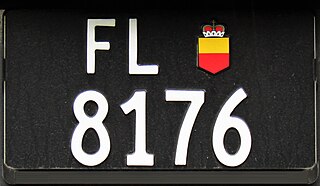
A vehicle registration plate, also known as a number plate or license plate or licence plate, is a metal or plastic plate attached to a motor vehicle or trailer for official identification purposes. All countries require registration plates for road vehicles such as cars, trucks, and motorcycles. Whether they are required for other vehicles, such as bicycles, boats, or tractors, may vary by jurisdiction. The registration identifier is a numeric or alphanumeric ID that uniquely identifies the vehicle or vehicle owner within the issuing region's vehicle register. In some countries, the identifier is unique within the entire country, while in others it is unique within a state or province. Whether the identifier is associated with a vehicle or a person also varies by issuing agency. There are also electronic license plates.
In Ireland, commonly referred to as the Republic of Ireland, vehicle registration plates are the visual indications of motor vehicle registration – officially termed "index marks" – which it has been mandatory since 1903 to display on most motor vehicles used on public roads in Ireland. The alphanumeric marks themselves are issued by the local authority in which a vehicle is first registered.

All motorised road vehicles in India are tagged with a registration or licence number. The Vehicle registration plate is issued by a Regional Transport Office (RTO) — the district-level authority on road matters in the respective state or Union Territory. The number plates are mandatory on both front and rear of the vehicle and are required to be in modern arabic numerals with latin letters. Complete specification of registration plates are specified under the HSRP: High Security Registration Plate rules.
Austrian car number plates are mandatory vehicle registration plates displaying the registration mark of motor vehicles in Austria. They are used to verify street legality, proof of a valid liability insurance and to identify and recognise the vehicle.

Vehicle registration plates in Hong Kong are managed by the Transport Department of Hong Kong. The physical number plates are not provided by the government but are made to order by garages. The vehicle registration system in Hong Kong is independent from that of Mainland China and Macau.
Vehicle registration plates in Singapore are administered by the Land Transport Authority. All vehicles in Singapore are required to display front and back plates bearing its registration number. Purchasers of vehicles have the option to bid for a vehicle registration number or get a vehicle registration number automatically assigned. Vehicle registration numbers can be retained on new or old vehicles owned by the same person. Vehicle owners are also able to replace and bid for a new registration number for existing vehicles.

Vehicle registration plates are mandatory number plates used to display the registration mark of a vehicle registered in France. They have existed in the country since 1901. It is compulsory for most motor vehicles used on public roads to display them.
Vehicle registration plates are the mandatory number plates used to display the registration mark of a vehicle, and have existed in Spain since 1900. Most motor vehicles which are used on public roads are required by law to display them. The government agency responsible for the registration and numbering of vehicles is the Directorate General of Traffic.

Malaysian registration plates are displayed at the front and rear of all private and commercial motorised vehicles in Malaysia, as required by law. The issuing of the number plates is regulated and administered by the Malaysian Road Transport Department or JPJ.

Thailand's vehicle registration plates are issued by the Department of Land Transport (DLT) of the Ministry of Transport. They must be displayed on all motorized road vehicles, as required by the Motor Vehicle Act, B.E. 2522 and the Land Transport Act, B.E. 2522. The plates vary in design, colors and dimensions according to the type of vehicle, but usually display a registration number and the vehicle's province of registration. Specifications are given in Ministry of Transport regulations. Current style started in 1975 for most vehicle types, but with small changes in 1997, and 1997 for motorcycles.

Vehicle registration began in the Isle of Man on 1 January 1906, following the Highways Act Amendment Act 1905.

Vehicle registration plates of the Principality of Liechtenstein are composed of the letters FL, followed by the small version of the coat of arms of Liechtenstein and up to five digits. The letters FL stand for Fürstentum Liechtenstein. Standard license plates show white characters on a black background, using the same type of font as Swiss license plates.
The vehicle registration plates of Cyprus are composed of three letters and three digits. A simple incremental numbering system is used; numbers run from 001 to 999 per letter sequence (alphabetic), so that, for example, the plate to be issued after MAA 999 would be MAB 001. However, registrants may be allowed to choose a number from available numbers in the extant letter sequence.

License plates are displayed on all motorized road vehicles in Brunei, as required by law. The issue of license plates is regulated and administered by the Brunei Land Transport Department. All vehicles must also display two of the same license plates numbers of the same colours at the front and rear of the vehicles. All vehicle license plates in Brunei, other than those issued to royalty, diplomats and taxis, have white characters on a black background, regardless of the vehicle type.

Since the end of the year 2000 Paraguay has required its residents to register their motor vehicles with the National Register of Vehicles and to display vehicle registration plates; this system has replaced the former one whereby plates were issued by municipal authorities, who also kept local registers.
The design for vehicle registration plates of Guyana consist of simple white lettering on a black plate. The format is 2 or 3 letters followed by 4 numbers. The 4 numbers are between 1 and 9999 with no leading zero.

In Bangladesh, the Bangladesh Road Transport Authority (BRTA) issues vehicle registration plates for motor vehicles. The vehicle registration plates in Bangladesh use the Bengali alphabet and Bengali numerals. They are produced by Bangladesh Machine Tools Factory, located in Gazipur. The current version of vehicle registration plates started in 1973, and the current digital number plates have been in use since 2012. The international vehicle registration code for Bangladesh is BD.
Vehicle registration plates are the alphanumeric plates used to display the registration mark of a vehicle, and have existed in the United Kingdom since 1904. It is compulsory for motor vehicles used on public roads to display vehicle registration plates, with the exception of vehicles of the reigning monarch used on official business.
In Nepal, all road vehicles with or without a motor are tagged with a registration number. This is issued by the state-level Transport Management Office, a government agency under the Department of Transport Management. The license plates must be placed in the front as well as back of the vehicle. The international vehicle registration code for Nepal is NEP.

Jamaica requires its residents to register their motor vehicles and display vehicle registration plates. Current plates are North American standard 6 × 12 inches.



















